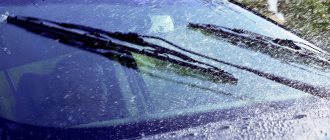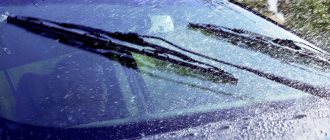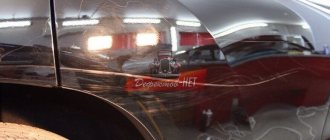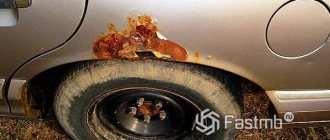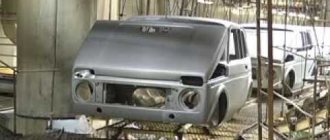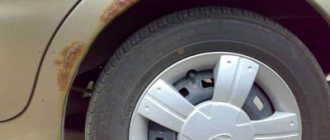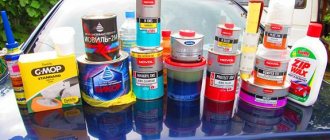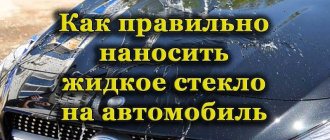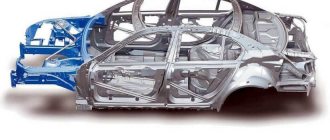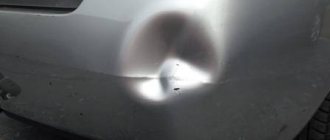The work can be done manually or using special machines
The main thing is to work carefully and slowly. There should be no deep scratches or rough transitions. Try to get a polished surface with smooth gradients.
A grinder is often included in a car enthusiast’s arsenal.
The damaged paintwork is removed layer by layer and subsequent damaged areas are processed.
The longevity of the result depends on the thoroughness of the work.
Universal types of putty, oddly enough, are not suitable for all types of car bodies
It is applied in several layers and each one is sanded until smooth. Your goal is to fill all the depressions and achieve a perfectly smooth surface when the work is completed.
To work, you will need several types of sandpaper.
Do not skimp on protective equipment, especially if you are doing the job for the first time.
Film, newspapers and masking tape are perfect for this. If you work outside, be sure to consider the direction of the wind.
Make sure that dust and other abrasive particles do not fall on the treated surface.
Painting work requires minimal skills!
The result is not always the same as in the photo; it is often necessary to modify and eliminate flaws
A good way to remove and repair rust on a car door (video)
Lada 2105 Atlantic › Logbook › Removing rust from a car body with your own hands.
The bodies of all cars are subject to corrosion, but it can and should be combated.
In this article I will tell you how to independently get rid of rust on the body of your favorite car, and thereby extend its life and improve its appearance. I will tell and show everything using the example of my own repairs. I did everything for the first time and it turned out very well. So, I think any car enthusiast can repeat this and save a lot of money on body repairs. So, let's get started... For repairs you will need:
— Sandpaper coarse (120) and fine (400 and 600); — Brushes for metal, but it’s better to use a grinder or an electric drill with a special attachment; — Degreaser; — Rust converter (Tsinkar) — Putty with fiberglass; — Regular putty; — Anti-corrosion primer in a can; — Paint in a can; — Masking tape and more newspapers; — Clean rags for degreasing;
This is what my car looked like before the repair:
Before starting work, you need to wash the car thoroughly so that all damaged areas are visible. After you have washed the car and prepared everything you need, you can begin.
1.
Clean the surface well to remove rust and old paint.
It is advisable to use a grinder or an electric drill with a special attachment for this; this will save you a lot of effort and time, and the repair will be of better quality.
If you are poor and you have neither an angle grinder nor a drill, then you will have to clean everything manually (as I had to do, because the angle grinder burned out almost immediately) with coarse sandpaper and a metal brush. Be careful when sanding the surface with coarse sandpaper. It is better to use sandpaper no rougher than 120 grit. I used 40 at first and made scratches that are visible even after painting.
2. Wipe and degrease the cleaned surface.
3.
Treat the cleaned surface with a rust converter.
This is necessary to eliminate rust at a chemical level and completely remove it.
5. Apply putty with fiberglass
to repair large dents or corrosion holes.
After it dries, smooth it out with coarse sandpaper. It will not be possible to completely level it, because it serves to seal large irregularities, like a foundation for ordinary putty. Important!
Try not to scratch the body while working with rough sandpaper! 7. Apply regular putty.
After it dries, sand it with sandpaper to a smooth surface.
9. We seal the places that we will not paint with masking tape and newspapers.
10. Apply anti-corrosion primer
I applied it from a spray can in 3 layers.
The 1st layer is the thinnest, the 2nd is thicker and the 3rd final layer is the fattest. Allow 10-15 minutes between coats to allow the primer to dry. In order for the primer to adhere well, you need to hold the can at a distance of 20-25 cm from the surface and make horizontal movements. If there is no major damage from rust on the body, then you can not putty, but immediately apply primer and paint.
11. Matte the soil with wet 600-grit sandpaper.
It is better to first soak the sandpaper in water for about 5 minutes. Then wait until the surface dries.
13. Painting.
In order for the paint to adhere well and without smudges, it must be applied from a distance of 20-30 cm and made horizontal movements.
The paint was applied in 4 layers, each subsequent layer being thicker than the previous one. Between layers I paused for 15-20 minutes to allow the paint to dry. Remember to shake the paint can periodically while painting.
Source
Removing rust, applying putty and primer
To remove corrosion using a chemical method, you can use several means, for example, various rust converters. However, the most effective of them is the B-52 Rust Destroyer. It should be noted that the composition does not work as quickly as described in the attached instructions, but you will see the result with the naked eye.
The reagent converts rust into a black substance, which must be removed with an electric drill with the same attachment, which looks like a small (0.3 millimeter) brush. Then wipe the area to be treated with solvent. It is not advisable to wash it with water, as indicated in the instructions, because unprotected metal will quickly become covered with new rust.
If necessary, repeat the procedure as many times as needed.
Further, the preparatory work, when local touch-up of the car is performed, if the damage is deep, it is necessary to continue leveling the surface with a special automotive putty. When the defect is superficial, the element can be primed immediately. It is best to use primer for this in an aerosol can, for example, the “Body” brand. Protect nearby areas of the car that will not be treated with plastic film, securing it with masking paper tape.
Spray putty and primer in a place protected from wind and dust, as well as other atmospheric influences. A spray booth is best suited for this. But, if it is not there, then work can be done in a garage that is suitably prepared for this.
Apply 2-3 layers of primer. After each layer has dried, sand it with fine sandpaper. Then thoroughly wipe the surface to be treated with solvent.
We remove rusty bugs from the body in 20 minutes: 2 ways for the lazy in 2021
During operation, “saffron milk caps” are formed on the paint surface of the car - small pockets of corrosion in the form of bugs. It is advisable to get rid of them as quickly as possible, preventing the spread of rust. This is accessible to every car enthusiast, since materials can be purchased at a reasonable price, and the work itself does not require special skills.
In some cases, the problem can be fixed very easily, so every driver can take care of the paintwork.
Stripping
Most often, rust appears in the form of bugs. This looks like minor damage to the paintwork. At the first stage, the paint simply swells, and underneath there is a source of rust. If the damage is small, you can use fine sandpaper; do not use coarse sandpaper.
If there is a lot of rust, then it is better to pick up an angle grinder. You can use a regular drill instead. To do this, you will need to purchase a brush attachment. As a rule, no special problems should arise during the stripping process. When carrying out work, be careful not to accidentally touch the good coating. Be sure to clean the area damaged by corrosion until it shines. Even the slightest trace of corrosion will cause the damage to grow rapidly.
But mechanical cleaning alone is not enough. You need to completely get rid of rust. For this purpose, treatment with an acid solution is used. In our case, the easiest way is to use phosphoric acid; it is also sometimes called soldering acid. It should be used to wipe off the corrosion area. In stores you can also find many specialized products for carrying out such an operation. Sometimes rust can be accompanied by dents. In this case, you will need to level the body using a layer of fiber putty. After application, it must be sanded.
Sandpaper and spray paint
For this method, you need to stock up on a can of paint to match the body color, primer, varnish, masking tape, some kind of plaster bar, a set of spatulas, automotive putty, sandpaper with a grit of P80, 120, 240, 400, 600, 800, a rust converter with spray, iron brush for metal, solvent, bucket of water, rubber gloves to protect hands.
Work to remove rust should be carried out in the following sequence:
In this case, the balloon must be held at an angle, moving the upper part back. The contents of the container must be constantly mixed by shaking it.
Chisel and paint with brush
After some time of use, many places appear on cars covered with rust in the form of small “bugs” that spoil the appearance of the car. Due to the small area of such corrosion centers, it is not necessary to completely paint the body.
To get rid of them, you can use a construction chisel, a rust converter, a special touch-up paint, or P120 sandpaper.
The work must be carried out in the following sequence:
MOTIP › Blog › Targeting bugs: fighting corrosion before frost sets in
Corrosion is hardly an unpleasant problem. This scourge can affect any paintwork and quickly ruin all your efforts to keep your car in perfect condition. There are many reasons for the appearance of so-called bugs on the body. This includes the aggressive effects of road chemicals in winter; and small but deep chips into which moisture has entered; and poorly carried out previous repairs. The result is rust, which poses a real threat to the integrity of your car's paintwork. At the same time, it is necessary to remove body defects before the onset of winter, because high humidity and temperature changes during the cold season will not only not stop corrosion, but will also worsen the problem. How to deal with bugs on your own - we decided to look into our material.
What are bugs on the body, and what is their danger?
Many car enthusiasts have heard words such as “bugs on the body.” At their core, these are small pockets of corrosion, which nevertheless must be removed from the paintwork. After all, rust has the unpleasant property of spreading quickly, especially if the car is in conditions of high humidity.
The cause of the development of a corrosion center can be a small chip, scratch or any other damage to the paintwork. In winter, humidity, constant temperature changes, as well as chemical reagents slowly but surely do their job - a small defect quickly turns into a large area affected by rust. The appearance of bugs on the paintwork may also indicate poor quality previous body work. After all, corrosion that has not been completely removed will continue its destructive work under newly applied coatings, and soon a fresh layer of paint and varnish will swell under the overgrown rust. If no action is taken, the affected area will increase in size and welding work or replacement of the damaged body part will soon be needed.
Based on the above reasons, it is better to start fighting corrosion from the moment it is detected on the body. We must try to quickly localize the source of rust and limit its spread, otherwise, as we have already said, the natural processes of iron oxidation will continue to develop and invade nearby areas. Certain parts of the body are more susceptible to bugs than others - fender arches, sills, and window frames. It is necessary to carefully inspect these elements and, if signs of corrosion appear, immediately begin to combat it.
Anti-bug technology
In order to thoroughly deal with the source of corrosion, you need to contact car service specialists. But it costs a lot of money, because body work is the most expensive. Therefore, if we are talking about eliminating one small bug, many people want to try to cope with this task on their own. Everything is possible if you follow the technology and do not forget about the main principle: corrosion and damaged varnish and paint must be removed entirely. If you do a little work in this direction, rust will show itself again, but on a larger scale.
First of all, the car is thoroughly washed from dirt using a special car shampoo, special attention is paid to the damaged area. Then the corroded area is cleaned with coarse abrasive paper (you can use a grinder or a drill with a metal brush). After this, the prepared area is treated with a rust converter primer. A good choice for carrying out such work would be, for example, the PRESTO rust converter primer. This composition must be applied even if it seems to you that you have completely removed the corrosion. The fact is that rust particles invisible to the eye could remain in the structure of the paintwork. The product, thanks to its special formula, helps eliminate corrosion without residue, and most importantly, prevent its reappearance by converting rust into a homogeneous organometallic compound. In addition, the converting primer creates a base for painting, after which the treated area can be puttyed or coated with any type of paint.
After the work is completed, the area to be treated is covered with paint and varnish. You don't have to buy a whole can of paint to paint a small area. There are small bottles with a thin brush that are convenient to use for this type of painting work. For example, Motip acrylic enamel in 12 ml bottles with a brush is perfect for local touch-up of the body after removing bugs and treating these areas with a converting primer. It’s easy to choose the right color using a convenient selection system or a color fan. By the way, it is always useful to have such a bottle in stock. It’s better to touch up a small chip right away, without waiting for corrosion to bloom on the damaged area of the paintwork.
Finally, the body is polished to hide the traces of your work as much as possible. Of course, we must understand that this will not be possible to do fully. As we have already said, an ideal result can only be obtained by a good master in a specialized car service center.
It is always better to prevent corrosion than to try to get rid of it. Therefore, clean the body well and carefully inspect for the appearance of pockets of rust. Well, don’t forget about anti-corrosion treatment!
Source
How to remove rust and bugs from a car body? Means and methods of combating corrosion
Rust is the most common and common problem that motorists have to deal with when servicing their car.
Corrosion damage to the body is very difficult to stop. To do this, it is necessary to promptly carry out a number of protective measures to ensure the safety of the body, rather than subsequently eliminating any damage. The most common cause of body damage is small crushed stone flying out from under the wheels of oncoming or passing vehicles, as well as chemical reagents that are used to reduce icing of the roadway and sidewalks.
Motorists often ask the question: “How to remove rust from a car body?” I will try to briefly answer this question.
The process of removing corrosion from a car body consists of several stages:
Car wash
The process of washing a car is carried out manually or with the help of mechanization, using special sprayers. Washing must be carried out outside and inside the body, as well as the engine and luggage compartments, while simultaneously inspecting metal surfaces.
To increase the efficiency of the washing process, it is necessary to use car shampoos, which provide thorough, gentle cleaning of the body and prepare the body for the necessary work. Car shampoo easily washes away dirt, salt and fats. Returns natural shine to surfaces and protects paintwork. The product does not contain wax, does not remove polishes, and does not leave stains or streaks. The composition of car shampoos does not contain phenols, formaldehyde preservatives and other toxic components.
For manual washing, the most widely used car shampoos are: Blesk-Premium, Lux-Premium, Car-Wash, Biolux.
When using automatic washing stations, Koch Chemie series car shampoo is widely used.
Drying the car body
Drying the car body can be carried out in natural conditions or using fan heaters. After washing, the car must be thoroughly wiped, removing all drops of water, which during drying in the sun can lead to the formation of stains on the surface of the body.
Inspecting the body and identifying areas with damaged surfaces requires the immediate installation of protective covers to prevent the ingress of chemicals and paint during painting work.
Carrying out rust removal work
When using a car for a long time, especially in humid climates (and not only), “bugs” form damage on the body. How to remove bugs from a car body?
There are two main methods used to process metal to remove rust:
This type of repair involves removing bugs from a car with your own hands, as a rule, it is carried out in a personal garage using a set of tools for car maintenance.
Mechanical method
How to remove bugs on the body? To do this, areas damaged by rust are usually treated with sandpaper or a wire brush. Cleaning the damaged area at the initial stage is carried out with coarse-grained sandpaper, with the transition to fine-grained sandpaper in the further processing process.
Sanding can be done using a “dry” or “wet” method. With the “wet” method, the metal surface is moistened with kerosene or white alcohol.
When using a metal brush for cleaning, you must be careful, since metal that is susceptible to corrosion is easily destroyed.
Rust can be removed from the car body using a grinding machine. A set-up sanding disc is suitable for this, with the help of which the layer of rust is removed and the damaged area is finally cleaned to obtain a smooth surface without traces of rust, using fine-grained sandpaper.
A very good result is obtained by using a sandblasting machine for cleaning, which combines high efficiency and helps prevent damage to the body. Removing rust using a sandblasting machine is carried out by cleaning the metal with a stream of air containing sand particles. This method allows for high-quality cleaning of damaged areas from bugs.
It should be noted that when using cleaning mechanisms, it is imperative to use safety glasses and gloves, observing safety regulations.
Chemical method
When using a chemical method to remove corrosion from a car body, various rust converting reagents are used. They are able to prevent the spread of corrosion in damaged areas. Companies producing car cosmetics offer a wide range of different products.
1. Among car enthusiasts, the composition “Rust Neutralizer VSN-1” has become widely known, after treatment with which, rust is converted into a gray substance that is easily removed with a rag.
2. The most commonly used product for removing rust from a car body is phosphoric acid, which is included in many rust conversion preparations.
3. Recently, motorists have been using zinc spray, which forms a protective film of zinc particles on the damaged area, thereby preventing the metal from reviving.
Retail stores offer a special “Zinkor-Auto” kit consisting of a solution for degreasing and removing rust, as well as a solution for coating the metal with a protective film of zinc particles.
When using the kit, the site of rust damage is treated with a rust converter, and then connected to the battery using electrodes and zinc particles are formed on the surface of the metal. During an electrochemical reaction, zinc particles coat the metal, forming a protective film.
Video: removing rust and galvanizing metal using the Zinkor-auto kit.
Additional processing
After cleaning the body from rust, a surface degreasing composition is applied to the damaged area and, after drying, another layer of anti-corrosion primer is applied, but this is only if the metal is clean. And if it happens that after cleaning the metal remains covered with factory primer, then there is no need for a primer.
Primers are used to protect the metal surface and provide better adhesion to the applied substances. Primers are available in three types:
Body putty and painting
A layer of putty is applied to the surface to be treated, which is processed using moisture-resistant sandpaper and leveled to a flat surface. The putty can be applied in several layers, and each time it is leveled with sandpaper to give it a smooth surface. And the last step before painting is applying a primer.
Video: correct application of putty and sanding it. Preparing for priming.
To paint the body, a paint color corresponding to the main color of the body is selected. It is better to choose the body color in a car repair shop using the paint number in the car’s passport. Painting is carried out using a paint sprayer, in at least three layers.
What materials and tools are needed
Cars from many well-known manufacturers are galvanized during the production process, which can significantly reduce the risk of rust on the body, but, alas, cannot be eliminated. Even a well-performed procedure cannot permanently protect the body from corrosion.
The aggressive action of the environment, microcracks and scratches lead to the appearance of rust spots that grow not only in width, but also in depth.
There are many options for cleaning a car from rusty bugs, and not all of them require contacting a car service. Some involve removing brown spots from the body yourself using budget funds.
In order to return the car to its marketable condition, you need to prepare:
All these tools will be needed to restore the body and prevent further spread of corrosion.
Important! You should not allow a large number of “bugs” to appear, since one small outbreak is much easier to fight than several.
From by car
Since childhood, we have all known the main enemy of iron – rust. It corrodes the metal, little by little making your personal vehicle unsuitable for movement. Rust appears on the body due to the destruction of the car’s paint layer, which is applied with a protective film during production. Minor scratches and damage allow oxygen and air access to the iron, which creates ideal conditions for the appearance of “bugs” on the car. The speed of spread of this infection depends on the environment: a humid climate with frequent precipitation speeds up the process several times. In winter, the situation is aggravated by the appearance of chemical reagents on the roads, which act like salt in a wound, corroding the car body even more deeply. What to do if rust appears on your car?
Step-by-step repair instructions
Before you begin directly removing traces of metal corrosion, the body must be thoroughly washed and dried. To achieve maximum effect, you should adhere to the following algorithm:
Next, all that remains is to remove the film and evaluate the result of the work done. The main thing is to check the body color for any sharp transitions that can ruin the appearance of the car.
Small single rusty spiders can be dealt with using a similar scheme. Thus, the area around the stain must be covered with tape even before the repair work begins, and the paint should be mixed in a separate container with varnish before applying it to the body.
Vehicle prevention and protection
Proper maintenance is the best way to protect your machine from corrosion. First of all, do not neglect regular car washing using wax. Thus, the treatment will protect the body from aggressive environmental influences, creating a kind of demarcation film.
We should not forget the importance of inspecting the car for the presence of “painful” lesions. Anti-corrosion treatment of the car's underbody, fender liners and mudguards will also extend the life of the paintwork.
Protecting a car from rust is much easier than getting rid of it. But if it was not possible to avoid the red bugs, then you should immediately begin to eliminate them, otherwise corrosion will eat the metal, making a through hole in the body.
Source
Corrosion removal steps
Restoring a car body from rust is carried out in the following sequence:
- Before removing bugs from the body, wash the car and degrease the area of corrosion. Any household solvent is suitable for degreasing - white spirit, acetone or industrial alcohol.
- Next, you need to clean off the rust on the car mechanically or chemically. The surface is cleaned down to the metal, this will reveal hidden areas of oxidation under the paintwork.
- If mechanical treatment of the car body against corrosion has been carried out, dusty residues of oxidized metal are removed from the surface. To do this, the body is treated with phosphoric, sulfuric acid or a rust converter.
- After the corrosion area has been completely cleaned, it is degreased again and treated with an anti-corrosion compound. Special primers that already contain a corrosion protection agent will help save time.
- Only after anti-corrosion treatment can you paint over the rust on the car yourself. Painting rust on a car is carried out in the following sequence: the area is puttied, primed and only after that paint is applied. When painting local damage, the “transition” method is used. After such painting, the boundary between the old and new coating is blurred, which makes the transition invisible.
- After the paint has dried from the surface of the part, defects are removed using fine sandpaper and polished.
Operation “Stop Rust”: ridding the car body of saffron milk caps and traces of rust on your own
A red scourge called rust plagues many car enthusiasts. The less protected the car body is from corrosion at the factory (galvanization), the more often the owners will have to make efforts to eliminate red spots. Moreover, it is undesirable to delay liquidation, since over time, damage to the metal only increases. As a result, in six months you will have to spend much more time and money than today. So, what will you need to remove rust and saffron milk caps with your own hands and how to remove them without harming the body.
Corrosion protection
Follow the simple tips below to protect your car from corrosion:
Regularly inspect your clean car for problem areas. Remove any small stains that appear in a timely manner. Remember: severe advanced corrosion will lead to expensive body repairs.
Take good care of your car, and then the methods described above will not be useful to you!
For 15 years I have been repairing various types of cars, including brands such as VAZ, UAZ, Chevrolet, Mazda, Kia and many others. Everything related to the gearbox, engine or chassis. You can write me your question below in the comments and I will try to answer it in detail.
The method of removing rust depends on the type of rust - deep or not deep. I usually don't let my car get too badly corroded. Therefore, I carefully rub off all small areas of rust with sandpaper, right down to bare metal. Then I degrease it, cover it with acid primer, apply enamel and paint.
I understand that if you are not a master and don’t understand, it’s better not to interfere and not do anything yourself. It's better to go to a service center. Otherwise you could damage your machine. I don’t even change the oil myself - it’s difficult for me. I go to the service center once every 3 months, the boys do everything perfectly, they charge strictly according to the price list. By the way, I also had the rust removed 2 months ago. They did an excellent job.
Source
Causes and places of rust on a car body
Rust is the oxidation of metal that occurs under the influence of air, water and static electricity. Therefore, the main reason for its occurrence is damage to the paintwork of the car body. Microcracks and physical damage allow air and moisture to reach the iron. The speed of the destructive impact will depend on the degree of protection of the body itself and the aggressiveness of the environment. This is especially true in winter, when many chemicals appear on our roads.
The above factors directly affect the shape, color and depth of corrosion. People call them differently: “saffron milk caps,” “bugs,” or simply “rusty spots,” but their essence is the same (only the degree of neglect varies). A single spot of rust is easier to deal with than many small red spots. The latter usually indicates poor quality metal or unsuccessful body repairs. The total processing area will be larger. Moreover, these points often spread in depth rather than in breadth. Blistering of the paint also signals the need to remove corrosion that has begun to develop under the paintwork.
The most common places for bugs and rust spots (photo)
Rust progresses well in places where there is increased exposure to foreign objects: sand, dirt, stones. The hood suffers from small stones from the tires of other cars, the wheel arches from their own “emissions” (by the way, wide non-standard tires or rims contribute to greater damage). The thresholds of the car are also one of the first to rot due to the close proximity to the “aggressive environment”, plus unsuccessful exits from curbs aggravate the situation.
Corrosion formation
Metal corrosion , or simply rust, appears as a result of metal oxidation under the influence of the environment. The main reason for its appearance is damage to the paint on the car body.
All resulting scratches and chips sooner or later become a source of rust formation, which gradually spreads deeper into the stain and over the entire larger surface area of the body.
The rate at which corrosion spreads depends on the aggressiveness of the environment and the condition of the body itself. For example, in the winter season it spreads many times faster.
It is much easier to deal with a single rust stain that has just appeared than with multiple “saffron caps” or an old stain where the metal is corroded almost completely.
The appearance of corrosion that is not yet visible to the eye is indicated by swelling of the paintwork. Such areas should be immediately cleared of old paint and cleaned.
Vulnerable places
The areas that experience the greatest mechanical stress are the most susceptible to corrosion. These include:
It is important to promptly detect emerging rust and eliminate it, preventing the further spread of corrosion. To do this, you need to know how you can deal with this unpleasant phenomenon yourself.
How to delete: options
We have become acquainted with the causes and places, let's move on to methods of correct elimination. There are two methods that differ in the way they remove rust:
You cannot do without the first method if the rust is strongly ingrained into the metal. Then it is necessary to completely eliminate traces of corrosion until pure iron (ideally shiny) remains. To do this, you may need additional tools and resources, which we will discuss below in step-by-step instructions. The second option is suitable for hard-to-reach places. These could be curves on the bottom of the car or the inside of the arches, which are difficult to process using mechanical means. Depending on the product, rust after chemical treatment can turn into foam (you need to rinse with water and dry the surface) or harden and become covered with a protective layer suitable for painting. Be sure to read the instructions and recommendations for the use of chemicals before purchasing. Before starting work, try to assess the extent of damage to the body and assess whether you can etch the damage with chemicals alone. For a positive result, it is necessary that “live” iron remains after the initial cleaning. If there are through holes or the final thickness of the metal after processing is too small, then more serious body repairs will be needed, that is, initially all these areas will need to be repaired using welding or putty with fiberglass.
How to touch up chips and scratches on a car body
No matter how carefully and carefully you use your car, over time, for one reason or another, scratches will still form on the surface of its body.
Based on the type of complexity, such damage is divided into three main categories:
- scratches on the top layer of paintwork material,
- scratches down to primer level
- and scratches to the metal.
To paint over a scratch on your car with your own hands, you can use special preparations and tools that are inexpensive and have a simple application method.
https://avtonomnaya-gazifikaciya.ru/obsluzhivanie/rzhavye-tochki-na-kuzove.html Source Source Source https://carlasart.ru/avtomobilistu/kak-podkrasit-skoly-i-tsarapiny-na-kuzove-avtomobilya. html
Reviews of the most popular tools and methods
The ideal option is orthophosphoric acid. Apply a thin layer to the camelina, wait 10–30 seconds, wipe dry with a cotton pad. It eats up rust and forms a phosphate film that is not afraid of water and is inert.
Maxim Leonov
https://avto-flot.ru/blog/kak-udalit-rjavchinu-s-kuzova-avtomobilya-i-ostanovit-ee-rasprostranenie.html
I already tried orthophosphorus - this is still an old-fashioned method, I processed what I cleaned. (As far as I know, all these inhibitors and converters are what it is, only in multi-colored bottles). Indeed, almost cleaned surfaces, this rubbish gets rid of rust residues. But untouched, so to speak, terry thickets of corrosion do not particularly react to it. So, they sizzle a little, darken, turn pale and remain in place.
https://forums.drom.ru/4×4/t1151267034.html
Nowadays, people no longer burn at the stake for the magic of transforming rust into pure and white metal, but a miraculous transformation does not happen either. And the zealous body workers continue to sand, etch, putty, treat with filler... And that’s why - because you can’t pull it out without difficulty... It’s impossible, you know, to rub it with a cloth and for it to become overgrown - it doesn’t happen. So go ahead, Shura, go ahead...
Zaika 2106
https://forum.auto.ru/chemistry/22048/
Mechanical method (step by step instructions)
If you follow the instructions and take your time, you can forget about rust on your car for 1-2 years (at least in the treated areas). The work is carried out in stages:
DIY Tools and Supplies
To work you will need:
The work can be done manually or using special machines
The main thing is to work carefully and slowly. There should be no deep scratches or rough transitions. Try to get a polished surface with smooth gradients.
A grinder is often included in a car enthusiast’s arsenal.
The damaged paintwork is removed layer by layer and subsequent damaged areas are processed.
The longevity of the result depends on the thoroughness of the work.
Universal types of putty, oddly enough, are not suitable for all types of car bodies
It is applied in several layers and each one is sanded until smooth. Your goal is to fill all the depressions and achieve a perfectly smooth surface when the work is completed.
To work, you will need several types of sandpaper.
Do not skimp on protective equipment, especially if you are doing the job for the first time.
Film, newspapers and masking tape are perfect for this. If you work outside, be sure to consider the direction of the wind.
Make sure that dust and other abrasive particles do not fall on the treated surface.
Painting work requires minimal skills!
The result is not always the same as in the photo; it is often necessary to modify and eliminate flaws
A good way to remove and repair rust on a car door (video)
Body putty and painting
A layer of putty is applied to the surface to be treated, which is processed using moisture-resistant sandpaper and leveled to a flat surface. The putty can be applied in several layers, and each time it is leveled with sandpaper to give it a smooth surface. And the last step before painting is applying a primer.
To paint the body, a paint color corresponding to the main color of the body is selected. It is better to choose the body color in a car repair shop using the paint number in the car’s passport. Painting is carried out using a paint sprayer, in at least three layers.
Properly selected and carried out treatment of the car body, adherence to the order of implementation of all technological processes will help motorists prolong the operation of the vehicle while saving money and time.
Do-it-yourself chemical way to get rid of corrosion
The chemical method differs only in the initial stage - cleaning the part from rust. According to reviews from manufacturers, these substances are able to eradicate rust, stop its further spread and do not damage the iron itself (unlike “sandpaper”). Application is very simple - apply the product to the rusty surface for 30-40 minutes, then wipe with a cloth or rinse with water. But to get a nice, smooth surface you will still have to clean, putty and polish (except for the initial stages of corrosion).
Some funds are available to motorists even with the most modest budget
There are kits on sale that allow you to independently apply a protective layer of zinc to the car body. The kit already contains a solution for removing rust and applying a protective layer, as well as an electrode with a zinc tip. This process is electrochemical, so a connection to a battery is required.
The kit includes liquids and all necessary working tools
Dry cleaning
Reagents quickly deal with plaque. They are also easy to use in places where your hands cannot reach. However, if the area is very thin, it is better not to use aggressive compounds. This can lead to complete destruction. The product is applied to the damaged area and left for several minutes. Depends on the composition. Then wipe it with a damp cloth and wash it. Next, putty, painting and varnishing are also carried out. The most popular products are zinc and rust neutralizer. With the help of zinc, the metal is cleaned and treated with a protective layer that prevents the formation of rust. The neutralizer easily removes the corrosion layer.
How to remove “saffron milk caps” and “bugs”
Many people want to believe that if rust has just appeared and the lesions are small, then they can be eliminated with some miracle remedy. Unfortunately, this is impossible in principle. The rust that appears on the surface of the paintwork is like the tip of an iceberg; the main damage is deep inside.
There are products on sale that will help remove the red color from the body. For example, there is Anti-Rust paste - it removes red spots quite quickly and well. This is the same rust converter that we discussed above. It eliminates the visible signs, but not the source itself. Such manipulations usually last for 2–6 weeks (depending on weather conditions), and they are most often used immediately before selling the car.
Small “bugs” sometimes cause big problems for the car seller!
If you want to get rid of the problem in the long term, then you cannot do without physical intervention. It is necessary to stop the access of air and moisture directly to the metal. Theoretically, you can prolong the effect of the paste if, after treatment, you cover the damaged area of the body with clear varnish. But it will work if the converter has managed to remove all the rust. In most cases, this does not happen, since the depth of penetration of the product is small.
Unfortunately, it will not be possible to hide damage for a long time only with the help of paste.
Vehicle prevention and protection
Tools available to every motorist, but which most of them ignore, will help you avoid the work done:
The work of eliminating “bugs” and “saffron milk caps” is within the power of everyone. But for a good result it will take scrupulousness and time (especially the first time). Think about whether you are able to prevent such sources of trouble. Advanced corrosion leads to expensive body repairs without guarantees. Take care of your car, and it will reciprocate.
Source
Why do rust spots appear?
The paint coating is subject to corrosion and rust from exposure to water and air. Small gaps, cracks and chips allow natural forces to reach the iron itself. This leads to rapid damage and loss of presentable appearance. A car deteriorates especially quickly in winter if it is left outside. Along with snow, not only moisture can get under the paint, but also chemical compounds that are sprinkled on roads.
